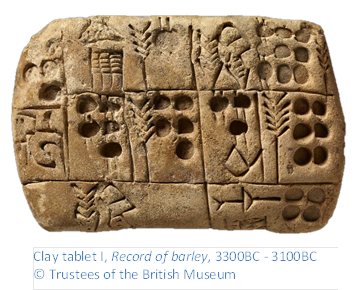If you answered ‘the letter X’, it may not be quite right. It may well be what you write – but do you know why? There are at least two stories for explaining how X came to represent ten. Both stories relate to how we gather, represent and share information, the motivation for this blog and, in a sense, the challenge for Cambridge Mathematics!
On representing information, I recently met a computer scientist: Dr Advait Sarkar. His PhD looked at designing tools for non-experts wishing to perform data analytics using machine learning. One key finding was "Reduce representational expertise requirements by always including at least one representation with zero abstraction.” In concrete terms, it helps if humans/novices can have a direct (one-is-to-one) visual representation of data when we first start symbolising information. Interestingly this may relate to the very origins of writing!

Many cultures started with number symbols that, often using fingers (digits), literally counted out the numbers.

So how did the Romans get to V for five and X for ten? Our understanding is that originally these numbers would have been represented using the same symbolism as above:||||| for five, |||||| for six, ... through to |||||||||| for ten and so on. This is where subitising comes in. Could you quickly/readily count or compare ||||||||| and ||||||||| ?
Subitising is the capacity to determine near-instantaneously the number of objects/symbols in a small set. What, one would say, is small? Well that depends on the species. Subitising is prevalent across species – fish, frogs, chickens, ... chimpanzees. It is a mix of nature and nurture, in that it is a trainable trait. Chimpanzees seem to be hardwired to be better at subitising than humans, with an almost photographic memory. You may wish to watch videos of Ai, Ayumu and others, trained to work with numbers in excess of ten, via inducements of perfectly cut 8mm cubes of apple.
Humans seem to have a subitising limit of about five or six. Hence the difficulty in determining |||||||| or |||||||||. Consequently, below are two possible variants of how X came to mean ten.
Story 1:
To clarify the counting of ‘large’ numbers, Romans placed a (half) notch at five and a (full) cross at ten  (early Roman twelve). In time the
(early Roman twelve). In time the  came to represent five, with a later shortening to
came to represent five, with a later shortening to  and the
and the  came to represent ten. Moreover, this ties in with why IV represents four, VI six, IX nine, and so on. It’s not 5-1=4 in Roman numerals but it is the I in IV that represents the four! Not an arithmetic system but a truly positional one.
came to represent ten. Moreover, this ties in with why IV represents four, VI six, IX nine, and so on. It’s not 5-1=4 in Roman numerals but it is the I in IV that represents the four! Not an arithmetic system but a truly positional one.

Moving to the second story as to how X came to become ten.
Story 2:
 five digits could be seen as a hand
five digits could be seen as a hand  and represented by a
and represented by a  . And two hands together
. And two hands together  would give a ten!
would give a ten!
It may not matter which story is true. Both illuminate how our number representations have come to be. Often, Roman numerals are disparaged as being primitive (little more than finger counting) when compared with our more efficient Indo-Arabic decimal number system. But fingers underlie the Indo-Arabic system too; it’s just that the Indians may have been more ‘efficient’.

What does make the Indo-Arabic decimal representation handier for large (and fractional) numbers is a mix of powers, addition and place value. And even then, there are more efficient decimal representations of number! The symbolic representation of number and of mathematics, the related history, mythology, and the impact of evolving needs and technology have much to contribute to the teaching and learning of mathematics. We will delve into more of this in future blogs.
Postscript: Whether the Roman ten arose as a crossed out ‘digit’ or as two ‘hands’, once the X was available as a letter, it established itself as the ten. This ‘X’ isn’t the same type of representation of number as ‘C’ or ‘M’. It may well be that a parsimony principle when it came to typesetting (using the same character for multiple meanings) has led to X being many things – ten, the classic symbol for an unknown, the multiplication sign, ... even the mark for an incorrect answer. Though in each case there may well be a mathematical or symbolic method in the madness!